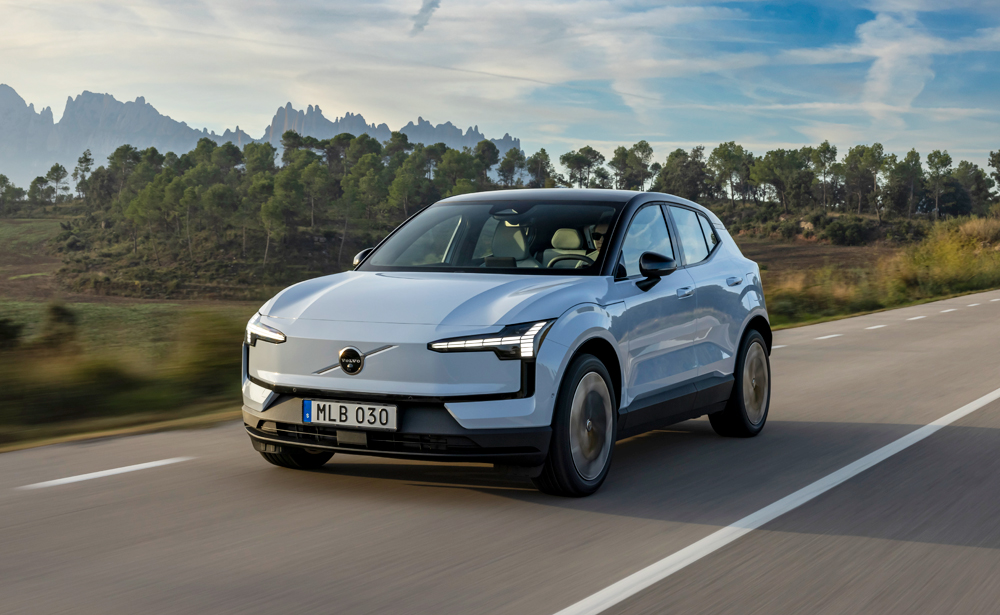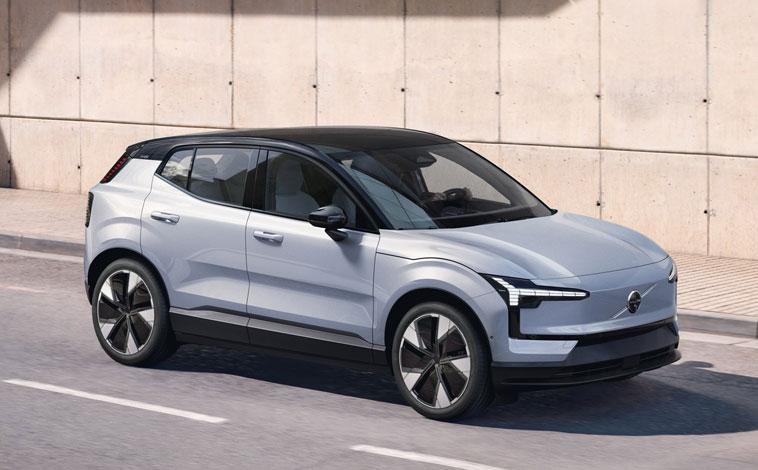
Volvo
EX30
The Volvo EX30 is a fully-electrified five-door SUV that’s very big on style, great to drive, packed with kit and also boasts an attractive price-tag. It is the Swedish company’s smallest SUV to date.
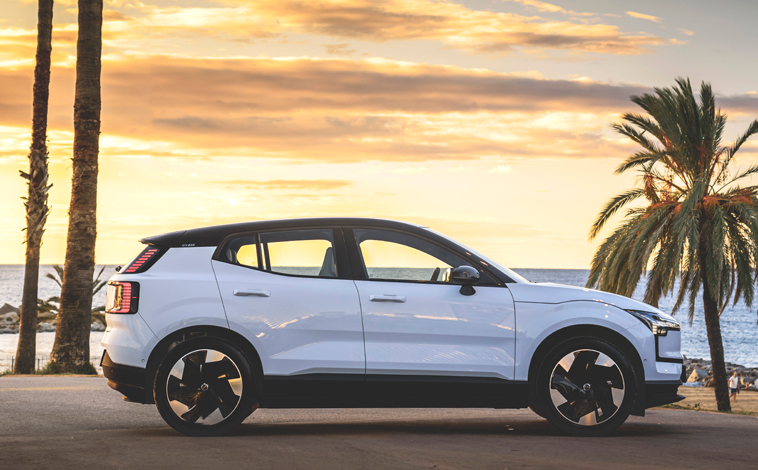
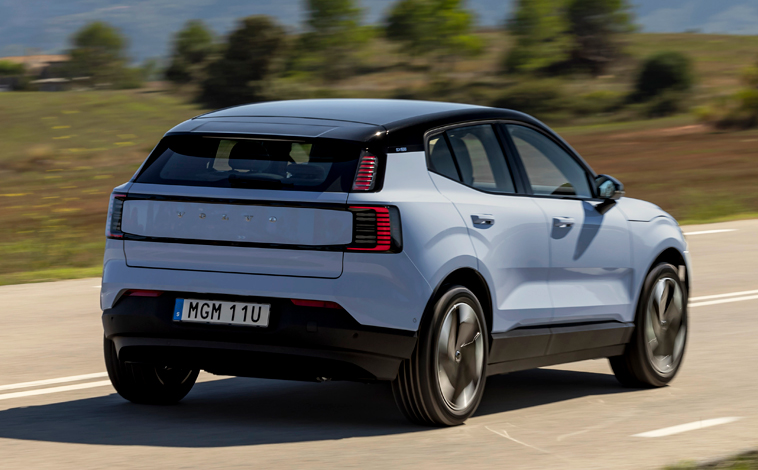
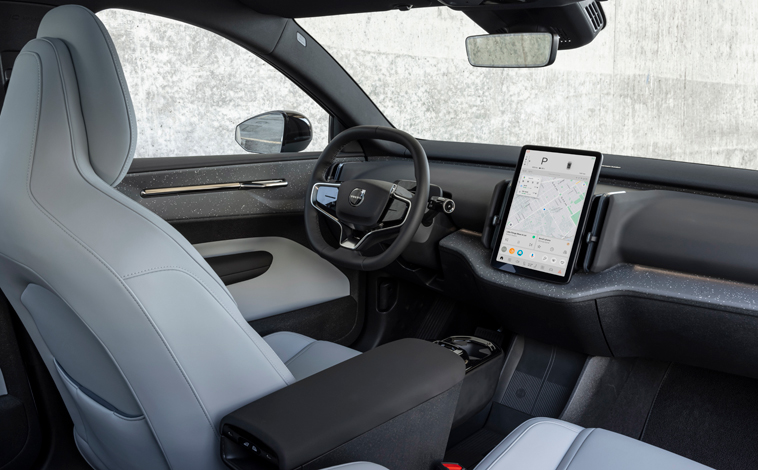
The good
Design, handling, range and pricingThe bad
Have to glance sideways to see the speedTech Specs
Test Drive
Volvo EX30 – First Drive (2023)
Volvo has launched an all-new fully electrified model – it’s the Swedish carmaker’s smallest ever SUV and it could prove quite the gamechanger in the industry.
That’s because the EX30 carries a very attractive price-tag despite being a great looking car, packed with technology and boasting a very decent driving range between charges.
It is available in two trim levels called Plus and Ultra with prices ranging from £33,795 to £44,495, but Volvo has announced an entry-level Core specification will be arriving a little later costing between £31k and £32k.
Apart from deciding on the trim level, customers have the choice of three powertrains. For starters, there is a Single Motor option with 272hp and a 51kWh battery – this has a driving range of 214 miles and is rear-wheel drive. A Single Motor Extended Range option with 272bhp and 69kWh battery can deliver up to 298 miles and this is also rear-wheel drive. Alternatively, there is a Twin Motor Performance version with 428bhp, a 69kWh battery, a driving range of up to 286 miles and this introduces all-wheel drive to the mix.
For our test drive, we chose the Single Motor Extended Range model in top-of-the-range Ultra specification, costing £42,045.
The EX30 certainly boasts a strong road presence with dynamic styling and plenty of eye-catching design cues. For example, the bonnet curves at the front and houses the Volvo emblem with sweeping light clusters each end plus signature LED daytime running lights. At the rear, the LED tail lights are connected by a light bar and the VOLVO name sits proudly on the square shaped tailgate.
Our car featured a fixed glass panoramic sunroof, Cloud Blue paintwork that changed shade depending on the sunlight, a black contrast roof and pillars that sparkled if the sun’s rays caught them at certain angles, plus 19-inch aero wheels – the Twin Motor Performance versions gain 20-inch alloys.
Moving inside, this five-door SUV is futuristic, clutter-free and very spacious. Customers can choose from four different interior styles – or ‘rooms’ as Volvo calls them. They are called Breeze, Indigo, Mist and Pine. Our test model had the Breeze design which, like all versions, focused heavily on sustainability featuring a high percentage of recycled materials incorporated into the upholstery and various surfaces.
For example, the main floor carpet has been crafted from 100 per cent recycled PET bottles, the dashboard covering is made up of ground waste from discarded PVC window frames and roller shutters, while the textile mats are made from fishing nets. Doesn’t sound too appealing, but believe me, it looks and feels amazing.
There is a large 12-inch upright infotainment screen that is the nerve centre and access point to the many on-board features. Creature comforts include a pitch perfect Harman Kardon sound system with a dashboard soundbar that stretches the width of the car and means there’s no need for door speakers, so freeing up extra space.
Owners get full smartphone connectivity, along with heated, powered front seats and a heated steering wheel. There is a 360-degree camera with virtual 3D view, Volvo’s Park Pilot Assist system and lots more besides.
But there is one immediate flaw with this minimalist approach. There is no driver display screen or head-up display which means the only place the car’s speed can be viewed is at the top of the infotainment screen. That’s most unlike Volvo, a company dedicated to making its cars the safest on the roads today.
But that aside, everything works well enough and the comfort levels for all occupants is sublime with room for two six footers up front and another two sat in the back. Add a third and it gets a little cosy, but would be fine on short journeys.
So the EX30 certainly looks the business and features all the bells and whistles we have come to expect from Volvo these days, but how does it handle when put to the test?
The answer is very well indeed. Our rear-wheel drive Single Motor Extended Range test car delivered 272hp and 343Nm of torque. It could sprint to 62mph from a standing start in 5.3 seconds, topped out at 112mph and, under WLTP testing, has a combined driving range of 296 miles between charges.
Owners get a keycard which is used to open the car by tapping it against the B pillar. Once this keycard is placed in a special tray inside the car, the vehicle will start automatically without any need for a start/stop button. This function will also be achievable on a smartphone.
The acceleration through the single-speed automatic transmission is rapid, smooth and constant with plenty of power on tap to overtake slower moving vehicles. It’s a confident motorway cruiser, but can also tackle more testing country lanes with lots of twisting lanes where the EX30 is nicely balanced with impressive grip and minimal body sway.
The steering is nicely weighted and, in bustling town centres, the car is agile and very easy to manoeuvre into tight parking spaces with the help of the excellent Park Pilot Assist system. And with lots of stop, start traffic, the single-pedal driving option is very welcome and also recoups energy that would otherwise be lost under braking.
Occupants are treated to a refined cabin experience with next-to-no noise intrusion and the majority of uneven surfaces smoothed out along the way by the highly effective suspension set-up.
The boot, accessed via a powered tailgate, can swallow 318 litres of luggage, a capacity that increases to 904 litres with the split-folding rear seats dropped flat. In addition, there is extra space beneath the bonnet which is ideal for storing the charging cables.
Alternative storage options include a glovebox that opens from the centre of the dashboard which has been designed to be easily accessible by either the driver or front seat passenger. There are front and rear cup holders, a large storage area between the front seats, seat back pockets and door bins.
And on the matter of charging, the EX30’s 69kWh battery can be boosted from 10 to 80 per cent in 11 hours, 30 minutes via an 11kW home wallbox or, if using a 175kW fast charger, it takes just 28 minutes.
All in all, when you factor in the comprehensive list of safety features and driver assistance aids, the EX30 is quite the all-rounder for any active family looking for a well-equipped EV that’s also very competitively priced.


